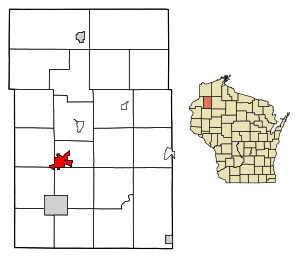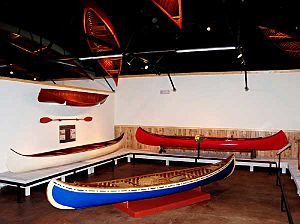Spooner, Wisconsin facts for kids
Quick facts for kids
Spooner, Wisconsin
|
|
|---|---|

Downtown Spooner
|
|
| Nickname(s):
Crossroads of the North
|
|

Location of Spooner in Washburn County, Wisconsin
|
|
| Country | United States |
| State | Wisconsin |
| County | Washburn |
| Area | |
| • Total | 4.27 sq mi (11.06 km2) |
| • Land | 4.03 sq mi (10.45 km2) |
| • Water | 0.24 sq mi (0.61 km2) |
| Population
(2020)
|
|
| • Total | 2,573 |
| • Estimate
(2020)
|
2,573 |
| • Density | 637.8/sq mi (246.26/km2) |
| Time zone | UTC−6 (Central (CST)) |
| • Summer (DST) | UTC−5 (CDT) |
| Area code(s) | 715 & 534 |
| FIPS code | 55-75625 |
Spooner is a city located in Washburn County, Wisconsin, in the United States. In 2020, about 2,573 people lived there.
Spooner is known as the "Crossroads of the North." This is because it sits where several important roads meet. These include U.S. Highways 53 and 63, and State Highways 70 and 253.
Contents
History of Spooner
Spooner started as a town in 1889 and officially became a city in 1909. Its story is very much connected to the history of railroads.
In 1879, the North Wisconsin Railway was built north of where Spooner is today. Later, the railroad moved its operations south. It connected with the Chicago and North Western Railway at a place then called Chicago Junction.
The community, which was just a train station at first, was named by Edwin W. Winter. He was a general superintendent for the Chicago and North Western railroad. He named it after John Coit Spooner (1843–1919). John Spooner was a famous railroad lawyer from Hudson, Wisconsin. He later became a politician, serving in the Wisconsin State Assembly and as a U.S. Senator for Wisconsin. He was a trusted advisor to several U.S. presidents, including Benjamin Harrison, William McKinley, and Theodore Roosevelt.
Over time, the Chicago & North Western Railroad took over these train lines. Passenger train service in Spooner stopped in the early 1960s.
In 1992, the Wisconsin Great Northern Railroad was created. It was meant to carry freight from Spooner to a nearby town called Trego, Wisconsin. Even though the freight idea didn't work out, they started running fun passenger train trips in 1997. These trips were very popular!
The company bought more of the train line in 1999. This allowed them to offer even more passenger train adventures. Today, they run popular themed trips like "robbery" trains, "western" trains, and special dinner trains. Their "Great Pumpkin" train around Halloween is also very popular and often sells out.
The old Chicago & North Western train station in Spooner is now the Railroad Memories Museum. It's a great place to learn about the area's train history. Spooner was also once a main center for the Omaha Railroad Line. The city's economy used to depend a lot on the two main train lines that met there.
Geography and Climate
Spooner is located at 45°49′33″N 91°53′28″W / 45.82583°N 91.89111°W.
The city covers a total area of about 3.52 square miles (9.12 km2). Most of this area, about 3.29 square miles (8.52 km2), is land. The rest, about 0.23 square miles (0.60 km2), is water.
Climate in Spooner
Spooner has a humid continental climate. This means it has warm, humid summers and long, cold winters. This type of weather is common in northern Wisconsin.
| Climate data for Spooner, Wisconsin (1991–2020 normals, extremes 1894–present) | |||||||||||||
|---|---|---|---|---|---|---|---|---|---|---|---|---|---|
| Month | Jan | Feb | Mar | Apr | May | Jun | Jul | Aug | Sep | Oct | Nov | Dec | Year |
| Record high °F (°C) | 57 (14) |
61 (16) |
81 (27) |
90 (32) |
104 (40) |
100 (38) |
110 (43) |
104 (40) |
99 (37) |
88 (31) |
74 (23) |
60 (16) |
110 (43) |
| Mean daily maximum °F (°C) | 20.7 (−6.3) |
26.4 (−3.1) |
39.5 (4.2) |
53.7 (12.1) |
66.7 (19.3) |
76.1 (24.5) |
80.1 (26.7) |
78.3 (25.7) |
69.6 (20.9) |
55.6 (13.1) |
39 (4) |
25.7 (−3.5) |
52.6 (11.4) |
| Daily mean °F (°C) | 10.8 (−11.8) |
15.4 (−9.2) |
28.6 (−1.9) |
42.4 (5.8) |
55.2 (12.9) |
64.9 (18.3) |
69 (21) |
67.1 (19.5) |
58.8 (14.9) |
45.8 (7.7) |
30.9 (−0.6) |
17.5 (−8.1) |
42.2 (5.7) |
| Mean daily minimum °F (°C) | 0.9 (−17.3) |
4.4 (−15.3) |
17.7 (−7.9) |
31 (−1) |
43.6 (6.4) |
53.7 (12.1) |
58 (14) |
56 (13) |
48 (9) |
35.9 (2.2) |
22.8 (−5.1) |
9.2 (−12.7) |
31.8 (−0.1) |
| Record low °F (°C) | −45 (−43) |
−46 (−43) |
−38 (−39) |
−7 (−22) |
13 (−11) |
22 (−6) |
35 (2) |
29 (−2) |
18 (−8) |
2 (−17) |
−26 (−32) |
−44 (−42) |
−46 (−43) |
| Average precipitation inches (mm) | 0.79 (20) |
0.8 (20) |
1.43 (36) |
2.77 (70) |
4.08 (104) |
4.23 (107) |
3.99 (101) |
3.9 (99) |
3.61 (92) |
3.16 (80) |
1.66 (42) |
1.19 (30) |
31.61 (803) |
| Average snowfall inches (cm) | 11.3 (29) |
9.6 (24) |
9.4 (24) |
4.8 (12) |
0.4 (1.0) |
0 (0) |
0 (0) |
0 (0) |
0 (0) |
0.8 (2.0) |
6.2 (16) |
13.2 (34) |
55.7 (141) |
| Average precipitation days (≥ 0.01 in) | 8.1 | 6.4 | 7 | 9.5 | 11.5 | 12.1 | 10.9 | 10 | 10 | 10.3 | 7.3 | 9.2 | 112.3 |
| Average snowy days (≥ 0.1 in) | 7.6 | 6.1 | 4.3 | 2.2 | 0.2 | 0 | 0 | 0 | 0 | 0.9 | 4.6 | 8.5 | 34.4 |
| Source: NOAA | |||||||||||||
People of Spooner (Demographics)
| Historical population | |||
|---|---|---|---|
| Census | Pop. | %± | |
| 1910 | 1,453 | — | |
| 1920 | 2,293 | 57.8% | |
| 1930 | 2,426 | 5.8% | |
| 1940 | 2,639 | 8.8% | |
| 1950 | 2,597 | −1.6% | |
| 1960 | 2,398 | −7.7% | |
| 1970 | 2,444 | 1.9% | |
| 1980 | 2,365 | −3.2% | |
| 1990 | 2,464 | 4.2% | |
| 2000 | 2,653 | 7.7% | |
| 2010 | 2,682 | 1.1% | |
| 2020 | 2,573 | −4.1% | |
| U.S. Decennial Census | |||
Population in 2020
In 2020, the census showed that 2,573 people lived in Spooner. There were 1,266 households, which are groups of people living together. About 94.9% of the people were White. Other groups included African American, Native American, and Asian people. About 2.7% of the population was Hispanic or Latino.
About 20.5% of households had children under 18. The average age in the city was 47 years old. About 20.1% of residents were under 18, and 26.7% were 65 or older.
Population in 2010
In 2010, there were 2,682 people living in Spooner. There were 1,180 households. The city had about 815.2 inhabitants per square mile (314.8/km2) people per square mile.
Most of the people were White (95.1%). Other groups included Native American, African American, and Asian people. About 1.3% of the population was Hispanic or Latino.
About 28.9% of households had children under 18. The average age in the city was 41.6 years. About 23.9% of residents were under 18, and 21.5% were 65 or older.
Fun Things to Do in Spooner (Attractions)
Spooner has some cool places to visit and fun events throughout the year!
- The Wisconsin Canoe Heritage Museum is a special place. It shows off many different canoes and tells the story of canoeing in North America. You can see old canoes and learn about how they were used.
- The Railroad Memories Museum is located in the old train station. It has a big collection of items and memories from the history of railroads.
- Every July since 1954, Spooner hosts the Heart of the North Rodeo. Thousands of people come to watch this exciting event. Besides the rodeo, there's a parade on Saturday, live music every night, and a special outdoor church service on Sunday.
- The Jack Pine Savage Days is a local festival. It features live bands, a fun run, and tournaments for basketball, horseshoes, and volleyball.
- The Jack O' Lantern Fest happens in October. This festival is all about helping kids and families. It has bouncy houses, a fundraising walk, a pumpkin roll, a pet costume contest, carnival games, and a pumpkin carving contest.
Famous People from Spooner
Some notable people have come from Spooner:
- Guy Benson – A mayor and a legislator (someone who makes laws).
- Felmers O. Chaney – A leader in the civil rights movement.
- Frank Hammill – A farmer, mayor, and legislator.
- John Lanzendorf – A hairstylist, helper of charities, and a huge collector of dinosaur art.
- Hal O'Halloran – A radio announcer and singer.
- Travis Randall – An actor, musician, and director.
- Holger Rasmusen – A mayor and a legislator.
See also
 In Spanish: Spooner (Wisconsin) para niños
In Spanish: Spooner (Wisconsin) para niños



